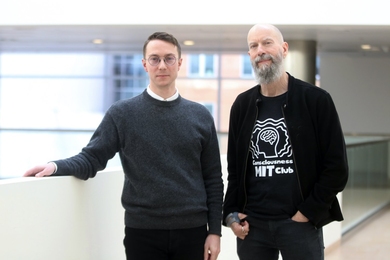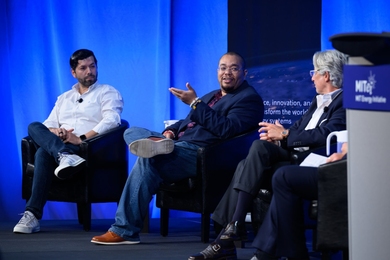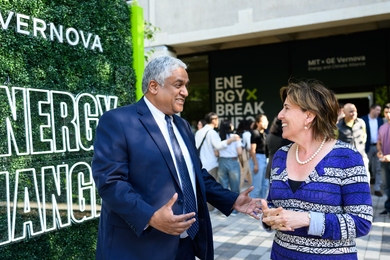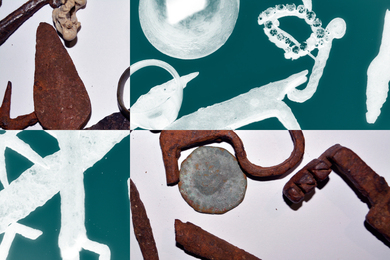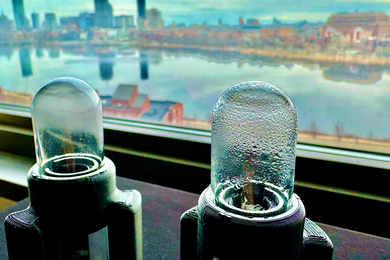Students in Dr. Carl Martland's Transportation Lab class (1.102) weren't able to get to a highway to test ways of measuring traffic flow last spring. So the highway came to them.
Actually, it was already here. The Infinite Corridor, a 940-foot-long highway complete with on- and off-ramps, episodic congestion and measurable traffic density, runs on an east-west axis from Building 7 at 77 Massachusetts Ave. to Building 8, via Buildings 3, 10, and 4. It was the perfect laboratory.
"The idea of a laboratory is to measure how things work," said Dr. Martland, a senior research associate in the Department of Civil and Environmental Engineering (CEE). "This project -- Finite Elements of the Infinite Corridor -- was a perfect exercise in traffic flow analysis. In the grand MIT experimental tradition, students had to get out of class, go out and measure the finite elements -- the numbers of people, their speed, the size of their groups -- of the Infinite Corridor.
"They found the corridor works just like a highway. Instead of rush hour or the Red Sox game letting out, we have Rm 10-250 emptying out between classes."
Dr. Martland's 14 students observed a number of practices particular to MIT culture, too. For example, pedestrians in the Infinite Corridor, like drivers of motor vehicles, agree on the optimal space between them -- about 4 feet. During summertime, individuals following one another really are separated by a 4-foot distance. During the winter, thanks to the extra 2 or 3 inches added by wearing down parkas, the real distance between them widens to 4 to 6 inches.
Bookbags, back packs and umbrellas have the same distancing effect, Dr. Martland said. In fact, he added, his students noted how it was a "breach of protocol to turn sideways while wearing a backpack or to use both shoulder straps to wear the backpack. Both actions took up more space and slowed the flow of students en route from one class to the next. This is a population very concerned with efficiency, with getting from place to place as quickly as possible. With just 10 minutes between classes, a delay of two or three minutes means a lot around here."
That concern for efficiency characteristic of MIT showed up in interviews with individual corridor travellers, Dr. Martland said. "Never assume behavior is random," he said. "One [corridor-traveling] student had four different routes going from east to west. Each was named after a famous railroad -- there was a Great Northern route, a Southern Railway route, and so on. Other students had alternate routes quite carefully worked out."
In the future, as Building 20 is replaced and that area of campus becomes a major destination, traffic patterns will change again, Dr. Martland predicted. However, looking at a map of the MIT campus, it's hard to plot a straight line from, say, Building 10 to Building 20. "That's too bad. MIT students don't like right-angle turns; they're not the most direct route," he said.
Also, if the MIT population expands and slows traffic through the Infinite Corridor, some students will take the high road -- literally.
"If it gets unbearable for them, athletic types are going to bound up the stairs, jog down the hall, and bound back down again. The older crowd will learn to avoid those times," Dr. Martland said.
The Transportation Lab was enthusiastic about using the Infinite Corridor as a lab, he said. One student, CEE junior Eliza Dubroff, was so enthusiastic that she turned the results of the group's observations into narrative form for extra credit. Below are excerpts from her report.
"The rules of the road for the Infinite Corridor include: stay to the right, limit group size, pass on the left, form a line at bottlenecks, don't stop/slow down, no tailgating, traffic within corridor has right of way, no physical contact and no eye contact.
"The trouble spots occurring at various bottlenecks can be a source of decreased efficiency even when the corridor is nearly empty. These trouble spots include 77 Mass. Ave., the portal from Lobby 7 into the corridor, Building 3, the stairways around Lobby 10 and Lobby 10 itself when the booths are set up, and Building 4/coffee shop -- the worst bottleneck in the whole system.
"Almost everyone in the MIT community uses the Infinite Corridor, but some, by the very nature of their schedules, use it much more than others. Freshmen, for instance, often have a class in Rm 26-100, then a class in Rm 10-250, then break for lunch in the Student Center, then another class in Rm 26-100. These people use the corridor upwards of 10 times a day.
"The people come into the corridor most often from one of the two ends. At the east end, people come most frequently from the east, up the north side of the entrance stairs; this is probably due to the location of the T stop and the lunch trucks (45 percent). People come from the southeast and from Building 26 with similar frequencies (22 percent and 21 percent respectively).
"From the west end, a large majority of the people came directly across the street (82 percent). People come from the Student Center or dorms. Ten percent of the people came southbound from Central Square or Random Hall. The last 8 percent came northbound from across the bridge.
"Clearly, since 82 percent of the people coming into the corridor from the west came across the street with the traffic light, there is going to be cyclic behavior within the building. The traffic light ranges in length from a 45-second cycle to a one-minute cycle depending on the time of day. Large surges of people come across the street at a time, and are spread out by the bottleneck at the entrance, but the effect of the traffic light is not completely lost.
"The highest documented flow (combined east- and westbound flows) was 163 people per minute at 1:58pm in Lobby 10. The worst travel time we experienced in our data collection was 3.7 minutes compared to the average travel time of about 2.5 minutes."
A version of this article appeared in MIT Tech Talk on August 27, 1997.

